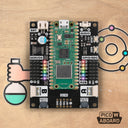Inventor 2040 W (Pico W Aboard)
by Pimoroni




An all-in-one board for making battery powered contraptions that can move, (optionally) make noise, and talk to the internet!
Inventor 2040 is a multi-talented board that does (almost) everything you might want a robot, prop or other mechanical thing to do. Drive a couple of fancy motors with encoders attached? Yep! Add up to six servos? Sure? Attach a little speaker so you can make noise? No problem! It's also got a battery connector so you can power your inventions from AA/AAA or LiPo batteries and carry your miniature automaton/animated top hat/treasure chest that growls at your enemies around with you untethered.
You also get a ton of options for hooking up sensors and other gubbins - there's two Qw/ST connectors (and an unpopulated Breakout Garden slot) for attaching breakouts, three ADC pins for analog sensors, photoresistors and such, and three spare digital GPIO you could use for LEDs, buttons or digital sensors. Speaking of LEDs, we've also somehow managed to fit in 12 addressable LEDs (AKA Neopixels) - one for each servo and GPIO/ADC channel (or just use the whole lot for making rainbows, that's fine too).
Best of all though, is the brains of the outfit - the onboard Raspberry Pi Pico W, which will give your creations 2.4GHz wireless connectivity. Use it to trigger your mechanical friends to do their thing remotely, or perhaps you can make a robotic bird that tweets, and also Tweets?
Features
- Raspberry Pi Pico W Aboard
- Dual Arm Cortex M0+ running at up to 133Mhz with 264kB of SRAM
- 2MB of QSPI flash supporting XiP
- Powered and programmable by USB micro-B
- 2.4GHz wireless
- 2 JST-SH connectors (6 pin) for attaching motors
- Dual H-Bridge motor driver (DRV8833)
- Per motor current limiting (425mA)
- Per motor direction indicator LEDs
- 2 pin (Picoblade-compatible) connector for attaching speaker
- JST-PH (2 pin) connector for attaching battery (input voltage 2.5V - 5.5V*)
- 6 sets of header pins for connecting 3 pin hobby servos
- 6 sets of header pins for GPIO (3 of which are ADC capable)
- 12 x addressable RGB LEDs/Neopixels
- User button
- Reset button (built in Captain Resetti!)
- 2 x Qw/ST connectors for attaching breakouts
- Unpopulated headers for adding a Breakout Garden slot
- Fully assembled
- No soldering required (unless you want to add the Breakout Garden slot).
- C/C++ and MicroPython libraries
- Schematic
Motors, servos, batteries and speakers are sold separately.
Software
Our C/C++/MicroPython libraries provide an easy way to interface with the functions on this board. You'll get best performance using C++, but if you're a beginner we'd recommend using MicroPython for ease of getting started.
Connecting Breakouts
The Qw/ST connectors make it super easy to connect up Qwiic or STEMMA QT breakouts. If your breakout has a QW/ST connector on board, you can plug it straight in with a JST-SH to JST-SH cable.
Breakout Garden breakouts that don't have a Qw/ST connector can be connected using a JST-SH to JST-SH cable plus a Qw/ST to Breakout Garden adaptor. Want to use >2 breakouts at the same time? Try this adaptor!
- List of breakouts currently compatible with our C++/MicroPython build.
Printables
Notes
- Measurements: 52mm x 66mm x 12mm (L x W x H). The mounting holes are M2.5 and 2.7mm in from each edge.
- The direction indicators for each motor can be disabled by cutting the "motor LED" traces on the rear.
- * The battery voltage range is dependent on what functions you're using! Minimum voltages from our testing:
- Motor driver stops working below about 2.9V
- Audio stops working below about 2.2V
- Pico stops working below about 1.9V
- You can have a battery and USB connected at the same time safely. The board will use whichever power source has the higher voltage (usually USB).
- Inventor 2040 W doesn't have battery charging circuitry onboard (this is so it's safe to use with either alkaline or LiPo batteries). You'll need an external LiPo charger (like LiPo Amigo) to charge the battery.
About Pico W Aboard
Our new Pico W Aboard products come with a built in Raspberry Pi Pico W. This means you get all the advantages of a RP2040 microcontroller - a speedy fast dual-core ARM processor, a dynamic, growing ecosystem and a choice of different programming methods to experiment with. Most excitingly though, Pico W has wireless connectivity, so your Pico/RP2040 devices can communicate with each other, and the internet! 🌍
We no longer stock this product
It's sad to say goodbye but sometimes we have to retire products to make way for new things.
Need a large quantity or a customised version? We may be able to help! Contact wholesale@pimoroni.com to discuss a custom build.
Check out these products that may be a suitable alternative:
-
 Inventor 2350 W (Pico 2 W Aboard) – An all-in-one board for making battery powered contraptions that can move, (optionally) make noise, and talk to the internet!
Inventor 2350 W (Pico 2 W Aboard) – An all-in-one board for making battery powered contraptions that can move, (optionally) make noise, and talk to the internet!
Shop with confidence – we've been serving the hobbyist electronics, Maker, and retro gaming communities since 2012.
- Satisfaction or refund guarantee
- Worldwide shipping via mail or courier
- 57,000+ customer reviews
- Secure website and payments


